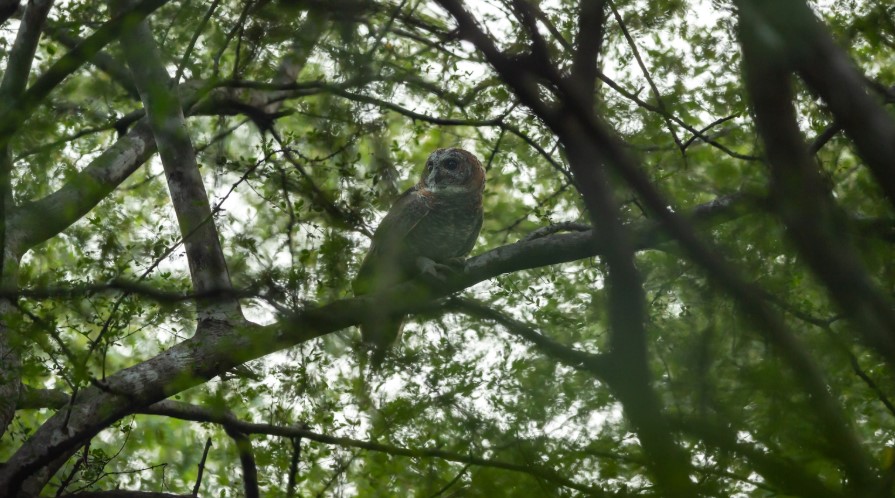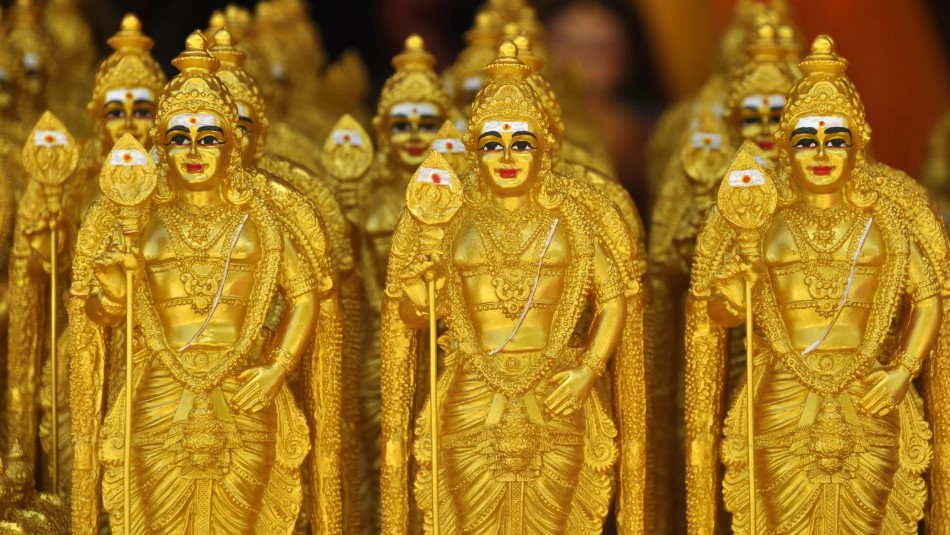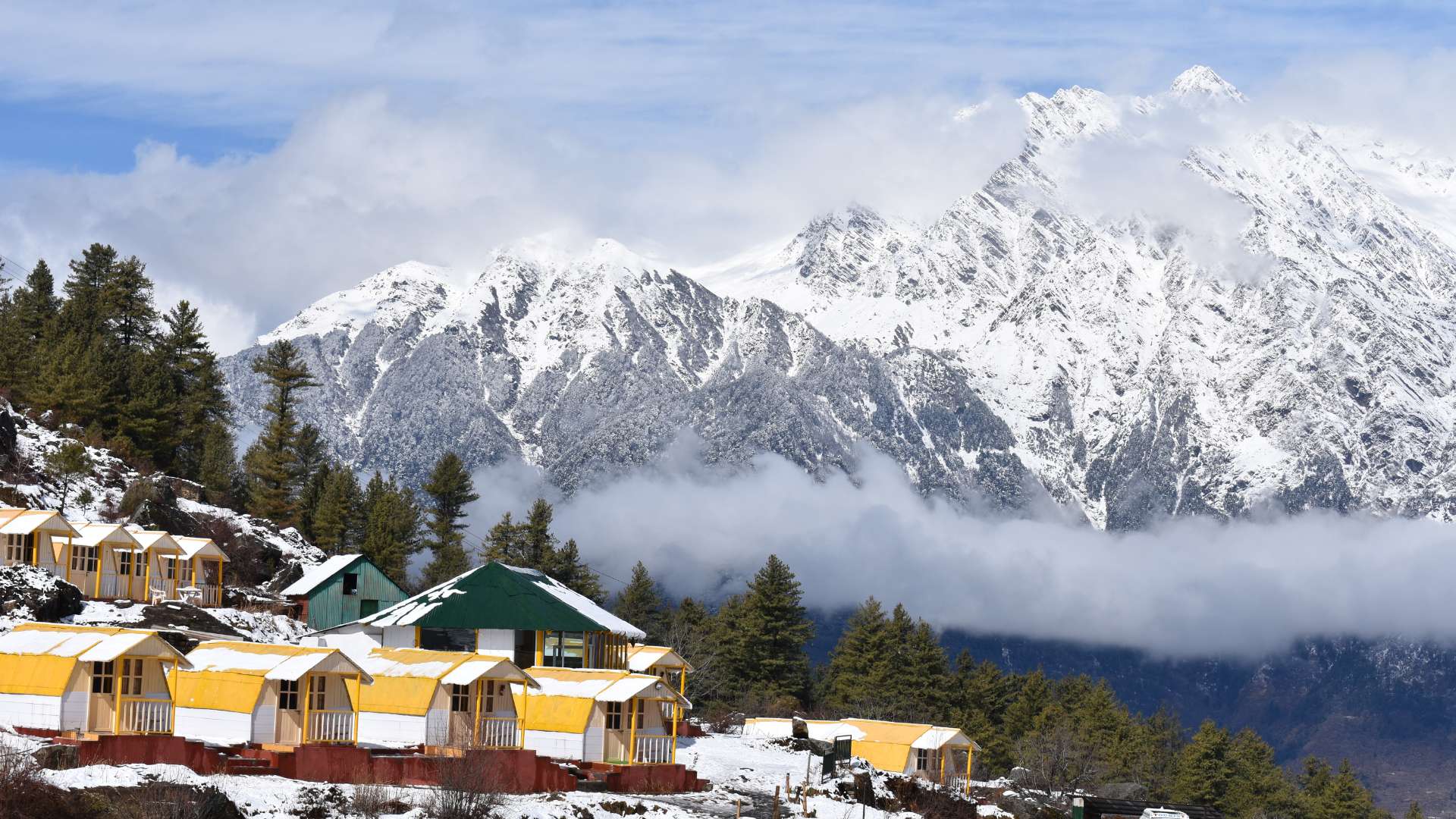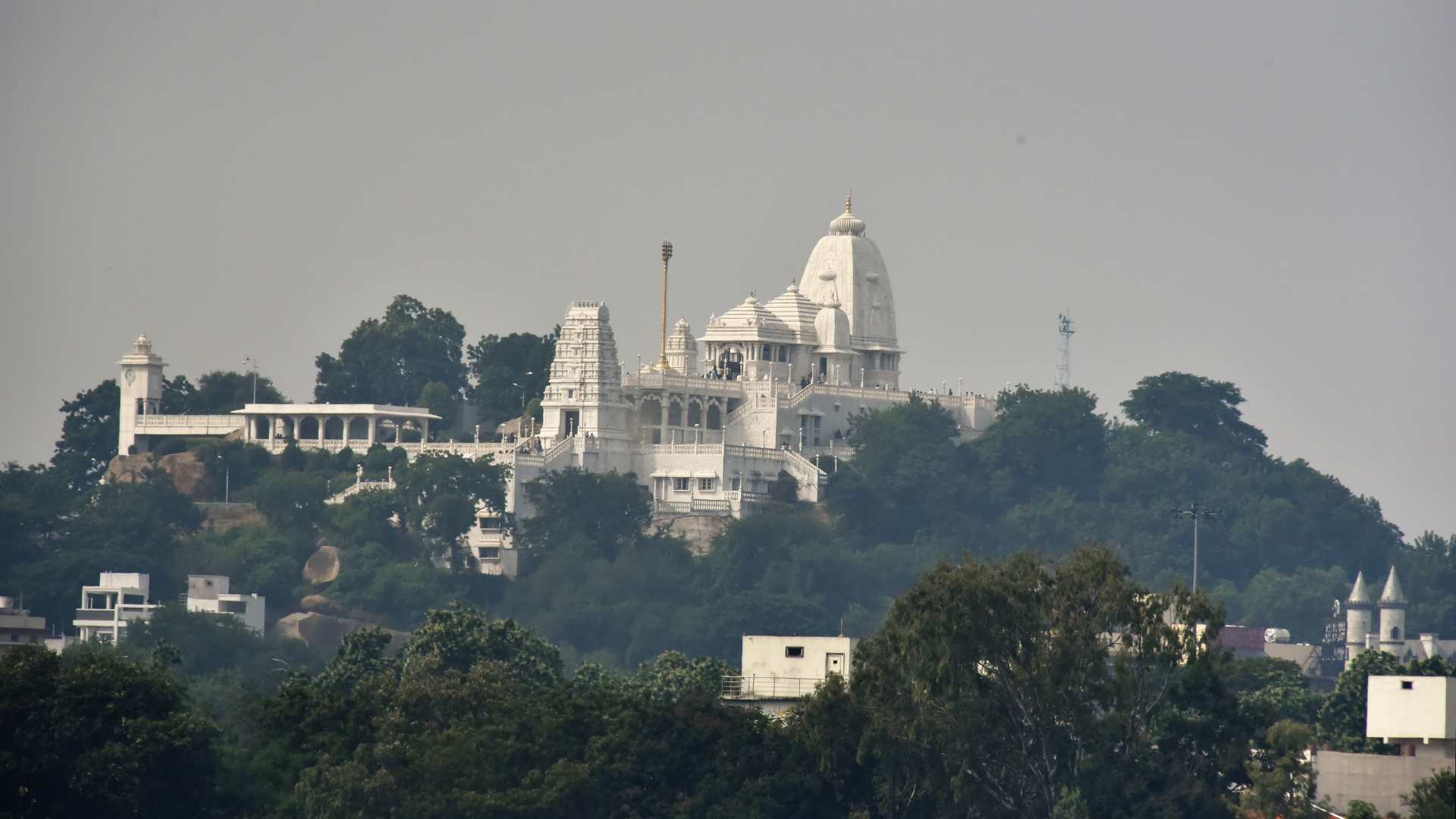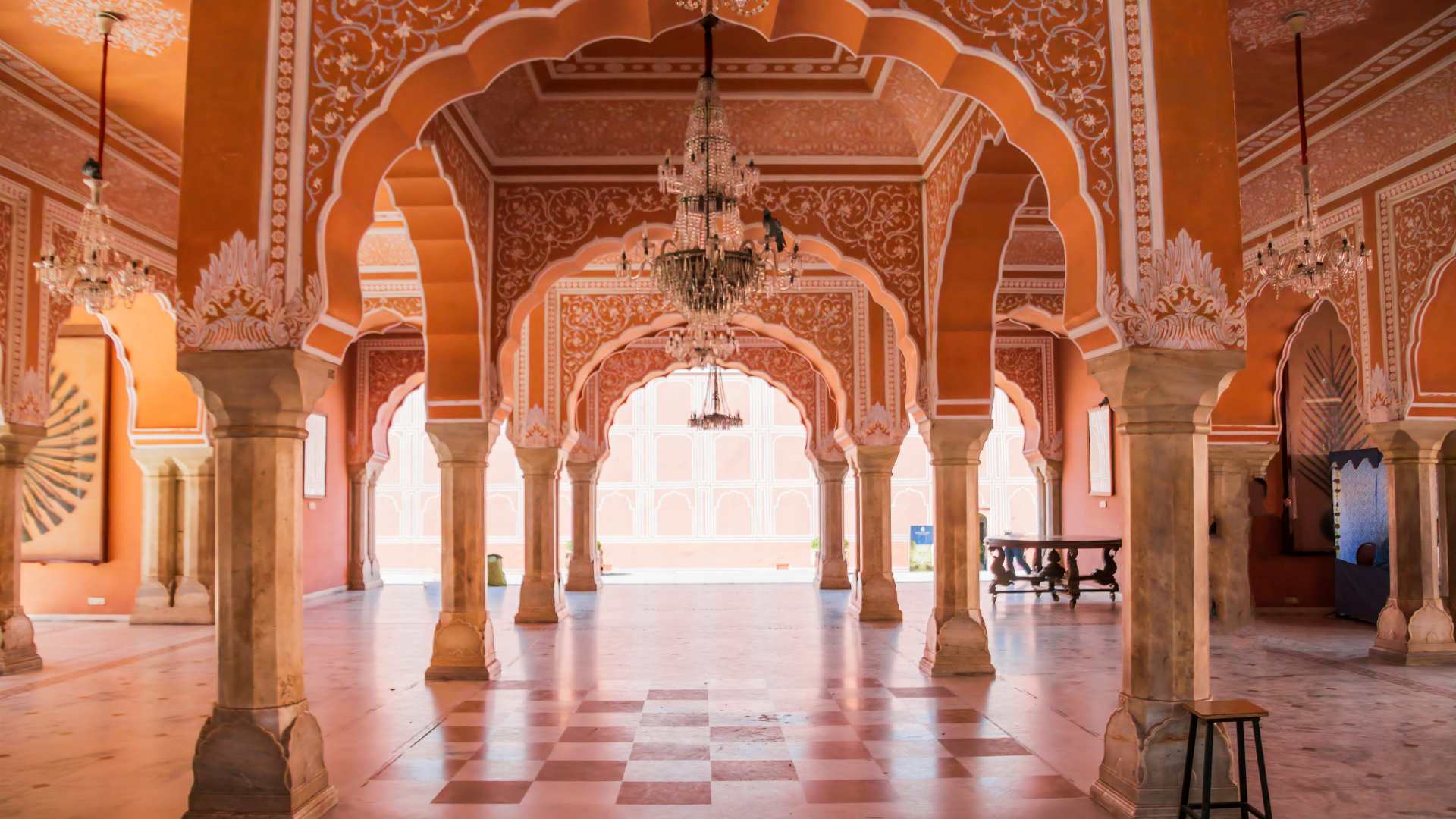Table of Contents
ToggleGujarat, a state rich in culture and tradition, is home to some of India’s most exquisite traditional outfits. The vibrant colors, intricate embroidery, and diverse styles of Gujarati dresses reflect the craftsmanship and artistic legacy passed down through generations.
For Gujarati women, traditional attire is more than just clothing; it celebrates their heritage.
Whether for festivals like Navratri, weddings, or cultural events, these garments showcase elegance and femininity.
From the iconic Chaniya Choli to the luxurious Patola Sarees, these outfits have become a symbol of Gujarat’s cultural identity, worn with pride by women worldwide.
In this blog, we’ll explore the Top 10 Gujarati Traditional Costumes for Females, each with its unique style, fabric, and cultural significance.
What Are the Different Types of Traditional Gujarati Dresses?

Traditional Gujarati dresses reflect the region’s rich cultural diversity. The Chaniya Choli, often worn during Navratri, is the most recognized outfit, combining vibrant colors and mirror work.
Bandhani Sarees, known for their intricate tie-dye designs, are commonly worn during religious festivals.
Bridal outfits like the Gharchola and Panetar sarees are iconic in Gujarati weddings, symbolizing purity and prosperity. Patola Sarees stand out due to their luxury and intricate double ikat weaving.
In rural Gujarat, garments like Kanjari and Abha Choli showcase detailed mirror work and embroidery, reflecting the craftsmanship of different communities.
These garments collectively demonstrate Gujarat’s deep-rooted textile heritage, varying from festive wear to everyday attire.
How Are Patola Sarees Different From Other Gujarati Sarees?
Patola Sarees are distinct due to their complex double ikat weaving technique, which requires immense precision and takes months to complete.
Unlike Bandhani or Gharchola sarees, Patola sarees are crafted from fine silk and feature geometric designs, often depicting elephants or flowers.
The vibrant colors and intricate patterns make them highly prized, especially during weddings.
On the other hand, Bandhani sarees use a tie-dye method to create their designs, while Gharchola sarees are known for their golden grid patterns and Bandhani work, making them bridal staples.
The meticulous craftsmanship behind Patola sarees makes them a luxury item, representing status and heritage.
What Role Does Embroidery Play in Traditional Gujarati Attire?
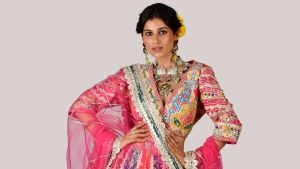
Embroidery is central to Gujarati attire, enhancing garments’ aesthetic and cultural value. Styles like Rabari and Bavalia embroidery are renowned for their vibrant thread work and mirror embellishments, often seen on Chaniya Cholis, Kanjari, and Abha Cholis.
These embroidery patterns frequently depict nature, animals, or geometric shapes, symbolizing local traditions.
Gold and silver zari work is also used in bridal outfits, such as Gharchola and Panetar sarees, to add elegance and richness.
Embroidery beautifies these garments and preserves cultural storytelling, as well as artisan craftsmanship passed down through generations.
How Has Modern Fashion Influenced Traditional Gujarati Outfits?
Modern fashion has influenced traditional Gujarati dresses by introducing lighter fabrics, contemporary designs, and simplified embellishments. Outfits like the Chaniya Choli and Patola Sarees are now made with materials like georgette and chiffon for comfort and affordability.
Brides opt for modern lehenga styles inspired by Panetar and Gharchola sarees, incorporating minimalistic designs while retaining traditional colors.
Casual versions of Bandhani Sarees and Kanjari blouses have also become popular, making them suitable for everyday wear. These adaptations keep Gujarati attire relevant while offering comfort and accessibility for modern-day fashion.
What Accessories Are Paired with Traditional Gujarati Dresses?
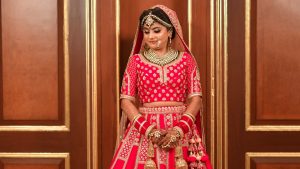
Traditional Gujarati dresses are often paired with accessories that enhance their cultural appeal. Gold jewellery, such as necklaces, bangles, and earrings, is commonly worn with sarees like Gharchola and Panetar.
For more casual outfits like the Chaniya Choli, silver jewelry including anklets and nose rings are preferred. Married women wear Mangalsutras and adorn themselves with a Maang Tikka for religious or festive events.
Accessories complete the outfit and hold symbolic value, representing status, marital significance, and cultural heritage, especially during weddings and festivals.
What Are the Regional Variations in Traditional Gujarati Attire?
Gujarati attire varies by region, showcasing the state’s diverse cultural landscape. In Kutch, women wear the Kanjari, a heavily embroidered blouse paired with a skirt or lehenga, often decorated with mirror work.
Saurashtra is known for its Bandhani Sarees, which are celebrated for their intricate tie-dye designs. Patan is famous for Patola Sarees, known for their labour-intensive double ikat weaving.
Even within traditional outfits like the Chaniya Choli, variations in embroidery styles and color palettes reflect the region’s cultural identity. These regional differences highlight Gujarat’s rich textile tradition, making each style unique to its origin.
Top 10 Gujarati Dress for Female
1. Chaniya Choli – The Essence of Gujarat

Image – Source
The Chaniya Choli is one of Gujarati women’s most recognized traditional outfits, especially during the Navratri festival. This ensemble consists of a flared skirt (Chaniya), a short blouse (Choli), and a dupatta (Odhni) draped over the shoulder or head.
The vibrant skirts are usually adorned with mirror work, beads, and intricate embroidery, making them perfect for the Garba and Raas dances.
Known for its flowing, dramatic silhouette, the Chaniya Choli symbolizes grace and elegance. Each region in Gujarat has its unique style of embroidery and patterns, making this dress an epitome of cultural pride and diversity. It is popular in Gujarat and across India during festival seasons.
Chaniya Choli Details
| Dress Feature | Description |
| Attire Name | Chaniya Choli |
| Craftsmanship Type | Mirror work, beadwork, intricate embroidery |
| Cultural Significance | Worn during Navratri and Garba festivals |
| Fabric & Material | Cotton, silk, and synthetic blends |
| Time to Create | Several weeks, depending on the complexity of the embroidery |
| Design Inspirations | Regional patterns, mirror embellishments, traditional motifs |
| How It’s Worn | Skirt with a fitted blouse and dupatta draped over the shoulder or head |
| Occasions to Wear | Navratri, weddings, cultural events |
| Accessories Paired With | Silver jewellery, bangles, anklets, and colorful bindis |
| Historical Significance | Traditional dance attire with roots in Gujarati festivals |
| Regional Variations | Kutch, Saurashtra styles featuring different embroidery patterns |
| Color Palettes | Bright colors like red, yellow, green, and blue |
| Contemporary Adaptations | Modern fabrics and subtle embellishments for a more casual look |
| Symbolic Importance | Symbolizes celebration and cultural pride |
| Artisan Expertise | Crafted by artisans skilled in embroidery and embellishment |
| Cost & Accessibility | Available in various price ranges, from affordable to luxury |
2. Bandhani Saree – Timeless Tie-Dye Craft
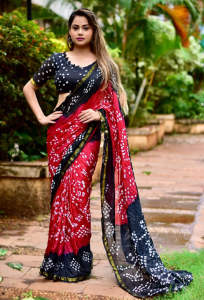
Image – Source
The Bandhani saree is a staple of Gujarati culture, known for its intricate tie-dye technique. Made using a traditional method called Bandhej, this saree features beautiful patterns and dots created by tying small portions of fabric and then dyeing it.
The resulting designs are vibrant and highly detailed, making the saree ideal for festivals and special occasions.
Bandhani sarees are known for their bright and auspicious colors, such as red, yellow, and green. They are often worn by brides and during religious ceremonies.
The pallu is draped in the distinctive Gujarati style, bringing out the intricate artistry of the design.
Bandhani Saree Details
| Dress Feature | Description |
| Attire Name | Bandhani Saree |
| Craftsmanship Type | Tie-dye technique (Bandhej) |
| Cultural Significance | Worn during festivals, weddings, and special religious events |
| Fabric & Material | Cotton, silk, and georgette |
| Time to Create | A few weeks to months, depending on design complexity |
| Design Inspirations | Dots, waves, geometric patterns using tie-dye |
| How It’s Worn | Draped traditionally with the pallu in the front over the right shoulder |
| Occasions to Wear | Weddings, Navratri, festivals |
| Accessories Paired With | Gold jewelry, bangles, anklets, and nose rings |
| Historical Significance | Centuries-old tradition of tie-dye originating from Kutch and Saurashtra |
| Regional Variations | Kutch and Jamnagar styles |
| Color Palettes | Red, green, yellow, and white |
| Contemporary Adaptations | Simplified versions with modern patterns |
| Symbolic Importance | Represents prosperity and good luck |
| Artisan Expertise | Skilled in tie-dye techniques passed through generations |
| Cost & Accessibility | Available from affordable to premium versions |
3. Gharchola Saree – A Bridal Favorite
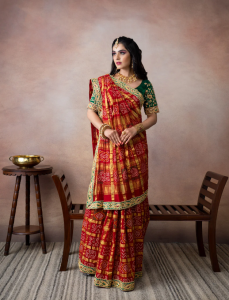
Image – Source
The Gharchola saree is a highly revered traditional bridal saree in Gujarat, often gifted by the bride’s family.
This saree is typically red or green, adorned with golden checks or squares, and made with fine silk. Gharchola is considered auspicious, symbolizing marital bliss and prosperity for the bride.
The saree’s defining feature is its golden grid design, created using the tie-dye Bandhani method.
The squares often feature detailed motifs like peacocks, elephants, or floral designs, adding a luxurious touch to the outfit. It’s commonly worn during wedding ceremonies and other festive occasions.
Gharchola Saree Details
| Dress Feature | Description |
| Attire Name | Gharchola Saree |
| Craftsmanship Type | Bandhani tie-dye, golden grid design |
| Cultural Significance | Worn by brides during wedding ceremonies |
| Fabric & Material | Silk, featuring golden squares |
| Time to Create | Several months, due to the complexity of the design |
| Design Inspirations | Golden checks, motifs of peacocks, elephants, and flowers |
| How It’s Worn | Draped with the pallu in the front, over the right shoulder |
| Occasions to Wear | Weddings, religious ceremonies |
| Accessories Paired With | Gold jewelry, maang tikka, bangles, and anklets |
| Historical Significance | An integral part of Gujarati bridal wear, symbolizing prosperity |
| Regional Variations | Kutch and Saurashtra variants |
| Color Palettes | Red and green with gold |
| Contemporary Adaptations | Lighter versions for modern brides |
| Symbolic Importance | Represents marital bliss and prosperity |
| Artisan Expertise | Crafted by weavers skilled in tie-dye and golden zari work |
| Cost & Accessibility | Premium price range, often a family heirloom |
4. Patola Saree – The Luxury of Double Ikat Weaving
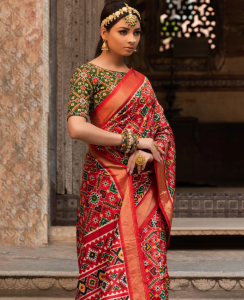
Image – Source
The Patola saree is one of the most luxurious traditional garments of Gujarat, known for its double ikat weaving technique.
Originating from Patan, this saree takes months to craft due to its intricate patterns and precision. Each saree is handwoven, making it a highly valued possession among Gujarati women.
These sarees are adorned with motifs like elephants, flowers, and geometric shapes, each carrying cultural significance.
Patola sarees are usually worn during weddings and special religious events, symbolizing status, wealth, and tradition.
Patola Saree Details
| Dress Feature | Description |
| Attire Name | Patola Saree |
| Craftsmanship Type | Double Ikat weaving, known for its precision and artistry |
| Cultural Significance | Worn by Gujarati brides and women during religious ceremonies and festive occasions |
| Fabric & Material | Woven from fine silk, featuring vibrant, intricate patterns |
| Time to Create | Can take several months to weave due to the complexity of the double ikat technique |
| Design Inspirations | Traditional motifs such as elephants, flowers, and geometric patterns |
| How It’s Worn | Draped with pleats in the front and the pallu elegantly draped over the shoulder |
| Occasions to Wear | Typically worn for weddings, Navratri, and other cultural celebrations |
| Accessories Paired With | Paired with gold jewelry, bangles, and traditional hairstyles |
| Historical Significance | Originates from the ancient silk-weaving tradition in Gujarat, passed down through generations |
| Regional Variations | Patan Patola (double ikat, premium quality), Rajkot Patola (single ikat, more affordable) |
| Color Palettes | Bright colors like red, green, yellow, and purple with complex geometric designs |
| Contemporary Adaptations | Modern versions use lighter fabrics and simpler designs, making them more accessible for everyday wear |
| Symbolic Importance | Represents status, elegance, and cultural pride in Gujarati society |
| Artisan Expertise | Crafted by highly skilled weavers in Patan using traditional techniques |
| Cost & Accessibility | Considered a luxury item, with original Patola sarees often priced in the higher range |
5. Kanjari – The Embroidered Long Blouse
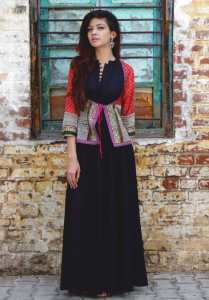
Image – Source
The Kanjari is a long, elaborately embroidered blouse traditionally worn by women in the Kutch region of Gujarat.
Known for its colorful mirror work and intricate embroidery, the Kanjari is usually paired with a skirt or lehenga, forming part of the traditional attire for festivals and special occasions.
The blouse is rich in design, with motifs inspired by nature and culture, making it a standout piece. Kanjaris are often worn during Navratri and other cultural celebrations, where they showcase rural artisans’ craftsmanship and vibrant artistry.
This traditional garment represents the cultural identity of the Kutch region and reflects the community’s artistry. Depending on the complexity of the embroidery, each blouse takes weeks to months to complete.
Kanjari Details
| Dress Feature | Description |
| Attire Name | Kanjari |
| Craftsmanship Type | Mirror work, colorful thread embroidery |
| Cultural Significance | Worn during festivals like Navratri and cultural events in Kutch |
| Fabric & Material | Cotton, silk, and blended fabrics |
| Time to Create | A few weeks depending on embroidery complexity |
| Design Inspirations | Floral and geometric patterns |
| How It’s Worn | Paired with a skirt or lehenga |
| Occasions to Wear | Daily wear, Garba, and cultural festivals |
| Accessories Paired With | Silver jewelry, bangles, anklets, nose rings |
| Historical Significance | Traditional attire worn by women in the Kutch region |
| Regional Variations | Variations in embroidery styles across different parts of Kutch |
| Color Palettes | Bright colors with contrasting embroidery |
| Contemporary Adaptations | Simpler versions for casual wear |
| Symbolic Importance | Reflects Kutch craftsmanship |
| Artisan Expertise | Skilled in embroidery and mirror work |
| Cost & Accessibility | Affordable to mid-range, depending on the design complexity |
6. Abha Choli – Shining with Embellishments
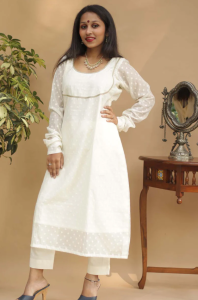
Image – Source
The Abha Choli is a beautiful, glossy choli often worn in the Kutch region of Gujarat. Studded with glass pieces and rich embroidery, this blouse is known for its vibrant look.
The Abha is typically paired with a skirt or lehenga, making it a common festive outfit during occasions like Garba and weddings.
Abha Cholis are decorative and showcase the artisan’s dedication to intricate detail. The reflective glass pieces create a striking effect, making the wearer stand out during festivals and cultural celebrations.
Abha Choli Details
| Dress Feature | Description |
| Attire Name | Abha Choli |
| Craftsmanship Type | Embroidery with reflective glass pieces |
| Cultural Significance | Worn during Garba, weddings, and other cultural events |
| Fabric & Material | Cotton and silk blends |
| Time to Create | Several weeks, depending on embroidery and embellishment complexity |
| Design Inspirations | Geometric patterns and floral designs using glass embellishments |
| How It’s Worn | Paired with a lehenga or skirt |
| Occasions to Wear | Garba, weddings, festivals |
| Accessories Paired With | Silver or gold jewelry, bangles, and nose rings |
| Historical Significance | Traditional wear for women in the Kutch region |
| Regional Variations | Varying styles of embellishments across different parts of Gujarat |
| Color Palettes | Bright colors, typically white, red, yellow, and green |
| Contemporary Adaptations | Modern adaptations feature fewer embellishments |
| Symbolic Importance | Represents cultural pride and festive celebration |
| Artisan Expertise | Skilled in embroidery and glass-studding techniques |
| Cost & Accessibility | Available in mid-range to luxury varieties |
7. Panetar Saree – The Classic Bridal Attire

Image – Source
The Panetar Saree is a significant part of Gujarati bridal wear, known for its iconic red and white color scheme.
Brides traditionally wear this saree during their wedding ceremonies. The white represents purity, and the red symbolizes prosperity. The saree features intricate Bandhani work on the pallu, making it a cherished piece.
Panetar sarees are usually made from silk or georgette, with golden zari work that enhances their beauty. This outfit is considered highly auspicious for Gujarati brides and is often passed down through generations.
Panetar Saree Details
| Dress Feature | Description |
| Attire Name | Panetar Saree |
| Craftsmanship Type | Bandhani work, golden zari embroidery |
| Cultural Significance | Worn by brides during wedding ceremonies |
| Fabric & Material | Silk or georgette |
| Time to Create | Several months due to the intricacy of Bandhani and zari work |
| Design Inspirations | Red and white color scheme with floral and geometric motifs |
| How It’s Worn | Draped with the pallu in the front, over the right shoulder |
| Occasions to Wear | Weddings, religious ceremonies |
| Accessories Paired With | Gold jewelry, nose rings, bangles, and maang tikka |
| Historical Significance | A traditional bridal outfit, passed down through generations |
| Regional Variations | Varying Bandhani patterns across different regions |
| Color Palettes | Red and white, with golden embellishments |
| Contemporary Adaptations | Modern brides opt for lighter fabrics for more comfort |
| Symbolic Importance | Represents purity and prosperity |
| Artisan Expertise | Skilled in Bandhani and zari techniques |
| Cost & Accessibility | Premium bridal wear, often considered a family heirloom |
8. Odhni – A Traditional Dupatta with Elegance
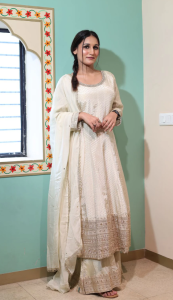
Image – Source
The Odhni, also known as a dupatta, is an essential part of traditional Gujarati attire, often paired with outfits like Chaniya Choli and Ghagra.
This piece of fabric is adorned with embroidery, mirror work, and intricate designs, enhancing the beauty of the outfit. It is often draped over the head or shoulder, adding elegance and modesty to the overall look.
Apart from its aesthetic appeal, the Odhni serves as a cultural symbol of grace and tradition. It is also used in rural areas to show respect during religious ceremonies.
Odhni Details
| Dress Feature | Description |
| Attire Name | Odhni (Dupatta) |
| Craftsmanship Type | Embroidery, mirror work, intricate designs |
| Cultural Significance | Worn as part of traditional attire during festivals and weddings |
| Fabric & Material | Silk, cotton, georgette |
| Time to Create | A few weeks depending on the level of embellishment |
| Design Inspirations | Floral and geometric patterns |
| How It’s Worn | Draped over the shoulder or head |
| Occasions to Wear | Cultural events, weddings, religious ceremonies |
| Accessories Paired With | Paired with Chaniya Choli or Ghagra |
| Historical Significance | An integral part of traditional Gujarati attire |
| Regional Variations | Different patterns and embroidery styles across Gujarat |
| Color Palettes | Bright colors like red, blue, green, and yellow |
| Contemporary Adaptations | Lighter fabrics and modern designs for casual wear |
| Symbolic Importance | Represents tradition and modesty |
| Artisan Expertise | Skilled in embroidery and mirror work techniques |
| Cost & Accessibility | Available in a wide price range, from affordable to premium |
9. Kediya – A Garba Favorite
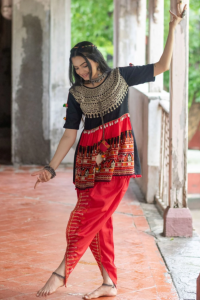
Image – Source
The Kediya, traditionally a men’s garment, has been adapted for women, particularly during Garba and Navratri celebrations. It’s a short, pleated frock-like top, often paired with tight-fitting churidar pants or lehenga for women.
This outfit is vibrantly colored and decorated with mirror work, tassels, and embroidery, giving it a festive appearance. The comfort and ease of movement it provides makes it a popular choice for dance.
Women typically wear a modern version of the Kediya, which has become a stylish option during Navratri. Its pleated design and light fabric allow freedom of movement during dance performances, making it practical while maintaining cultural authenticity.
Kediya Details
| Dress Feature | Description |
| Attire Name | Kediya |
| Craftsmanship Type | Mirror work, embroidery, tassels |
| Cultural Significance | Worn during Navratri and Garba celebrations |
| Fabric & Material | Cotton, silk, and blended fabrics |
| Time to Create | A few weeks to produce due to embellishments |
| Design Inspirations | Traditional Gujarati motifs with mirror and thread work |
| How It’s Worn | Paired with churidar or lehenga for women during Navratri |
| Occasions to Wear | Navratri, Garba, and festive events |
| Accessories Paired With | Silver jewelry, bangles, and anklets |
| Historical Significance | Traditionally worn by men; now a popular women’s outfit for Navratri |
| Regional Variations | Kutch and Saurashtra styles with different embroidery techniques |
| Color Palettes | Bright colors like red, green, and yellow |
| Contemporary Adaptations | Simpler designs for casual wear during Garba celebrations |
| Symbolic Importance | Represents festivity and cultural pride |
| Artisan Expertise | Crafted by skilled artisans in embroidery |
| Cost & Accessibility | Available in mid-range to luxury, depending on design intricacy |
10. Rabari and Bavalia Embroidery – A Reflection of Craftsmanship
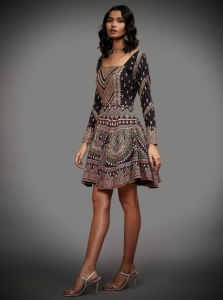 Image – Source
Image – Source
Rabari and Bavalia embroidery represent some of the most intricate embroidery styles seen in Gujarati traditional attire. Rabari embroidery, originating from the Rabari community, is known for its bold designs, featuring colorful threads and mirror embellishments.
These designs often depict daily life, animals, and nature, making them vibrant and deeply rooted in cultural storytelling.
Bavalia embroidery, on the other hand, is more geometric and structured, commonly found on everyday garments. Both styles add cultural depth and craftsmanship to the attire, making them popular in both traditional and modern fashion.
Rabari and Bavalia Embroidery Details
| Dress Feature | Description |
| Attire Name | Rabari and Bavalia Embroidery |
| Craftsmanship Type | Embroidery with mirror work and colorful threads |
| Cultural Significance | Popular in rural Gujarat and worn during festivals and special events |
| Fabric & Material | Cotton, wool, and silk |
| Time to Create | Weeks to months depending on the complexity of the embroidery |
| Design Inspirations | Nature, animals, geometric patterns |
| How It’s Worn | Embroidered blouses, lehengas, and dupattas |
| Occasions to Wear | Festivals, cultural events, and casual wear |
| Accessories Paired With | Silver jewelry, bangles, and anklets |
| Historical Significance | Represents the artisanal heritage of the Rabari and Bavalia communities |
| Regional Variations | Variations in thread colors and motifs based on the community |
| Color Palettes | Bright colors like red, yellow, green, and blue |
| Contemporary Adaptations | Integrated into modern fashion for both traditional and casual outfits |
| Symbolic Importance | Symbolizes rural life and craftsmanship |
| Artisan Expertise | Crafted by highly skilled artisans |
| Cost & Accessibility | Affordable to mid-range depending on the level of detail |
Conclusion
Gujarati traditional dresses are not just pieces of clothing; they are expressions of the rich cultural heritage, intricate craftsmanship, and deep-rooted traditions that define Gujarat.
From the colorful Chaniya Choli worn during Navratri to the luxurious Patola sarees crafted with painstaking precision, each outfit tells a story of artistry and pride.
Whether it’s a bridal Panetar saree or an everyday Kanjari blouse, these garments have evolved over the years but continue to hold their cultural significance. These timeless outfits remain an essential part of Gujarat’s identity, celebrated across India and beyond.
FAQs About Gujarati Dress for Female
What are the main traditional outfits for women in Gujarat?
The main traditional outfits for women in Gujarat include Chaniya Choli, Bandhani sarees, Patola sarees, and Gharchola sarees, adorned with mirror work, embroidery, and other intricate designs.
What is the significance of the Panetar saree?
The Panetar saree is a traditional bridal saree in Gujarat, symbolizing purity and prosperity. It is typically whiteFAQ Section
What are the main traditional outfits for women in Gujarat?
The main traditional outfits for women in Gujarat include Chaniya Choli, Bandhani Saree, Patola Saree, and Gharchola Saree. These are often decorated with intricate mirror work, embroidery, and vibrant color palettes, reflecting the region’s rich craftsmanship.
What is the significance of the Panetar saree?
The Panetar saree is a traditional bridal saree worn by Gujarati brides, symbolizing purity (white) and prosperity (red). It’s considered highly auspicious and is often passed down through generations as a family heirloom.
How are Bandhani sarees made?
Bandhani sarees are made using a traditional tie-dye technique known as Bandhej. Small sections of fabric are tied and dyed to create intricate patterns. These sarees are commonly worn during festivals and weddings.
What makes Patola sarees unique?
Patola sarees are known for their double ikat weaving technique, which requires immense skill and precision. These sarees are made from fine silk and feature complex geometric designs, making them a symbol of luxury and craftsmanship.
How is the Chaniya Choli worn during Navratri?
The Chaniya Choli, consisting of a flared skirt, blouse, and dupatta, is traditionally worn during Navratri. It’s often adorned with mirror work and vibrant patterns, allowing for ease of movement during Garba and Raas dance.
What is the cultural significance of the Gharchola saree?
The Gharchola saree, often worn by brides, symbolizes marital bliss and prosperity. It features a grid-like pattern created using Bandhani work and golden zari, making it a favorite for weddings and religious ceremonies.



